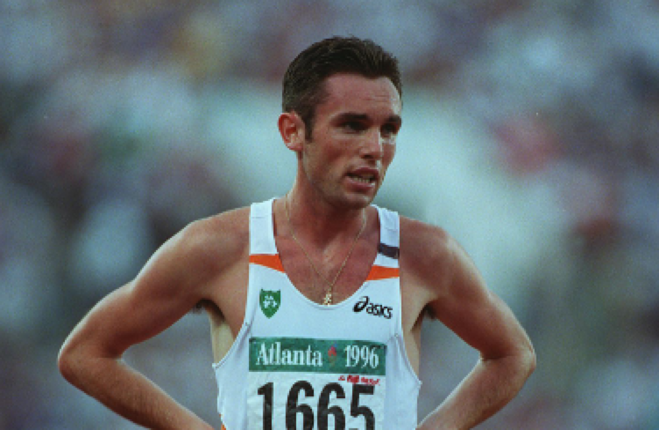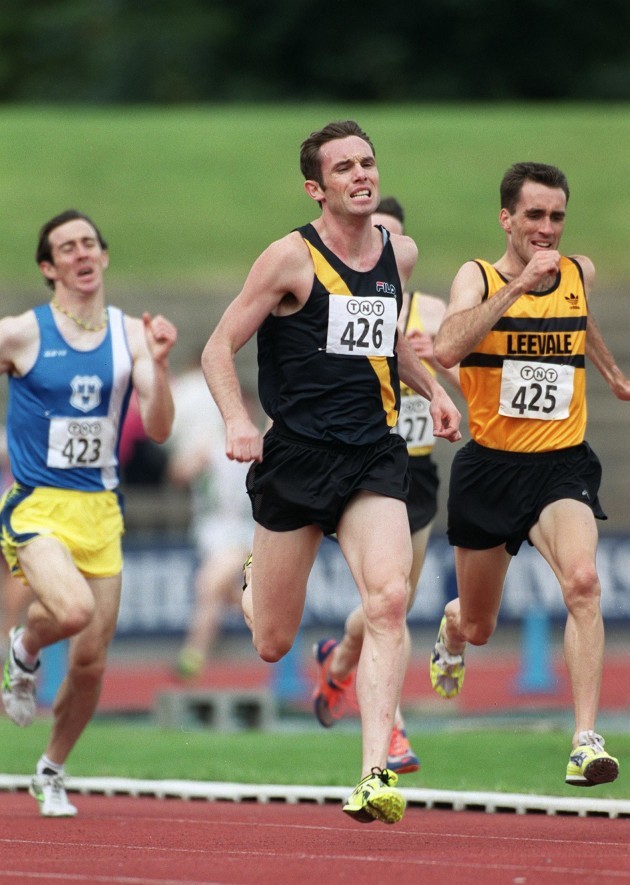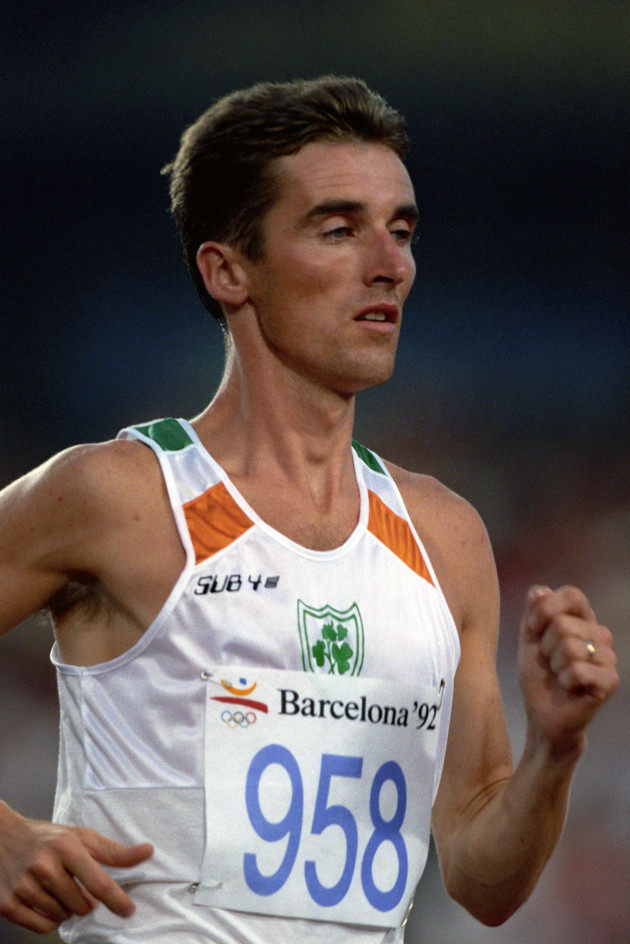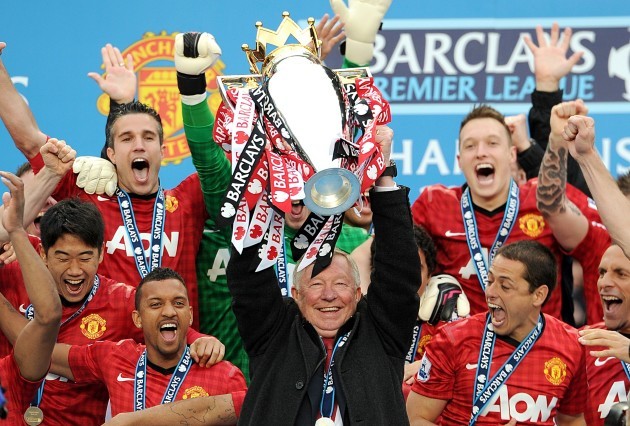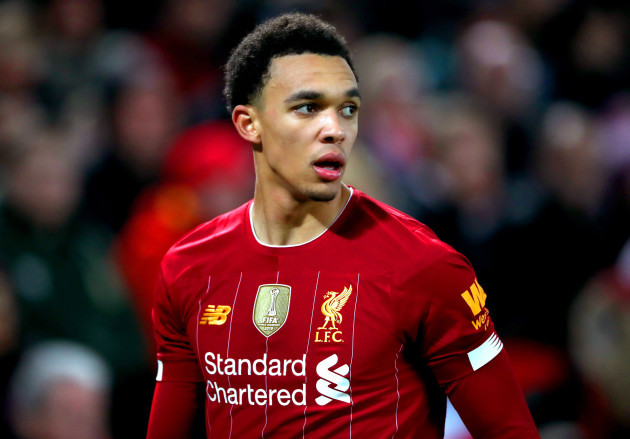WHEN NIALL BRUTON meets up with The42, he’s just after giving a talk at the Sport Ireland Institute in Abbotstown.
The Irish former 1500m runner spoke of his athletics career, and the various challenges he encountered, much as he is about to do now.
It was an event he was happy to be part of, though he readily admits such a request would have unquestionably been turned down 10 or even five years ago.
For a long time, he had been trying desperately to escape his past.
***
It’s not unusual for a young person to feel a sort of invincibility, particularly if they happen to be a gifted athlete. This was true of Niall Bruton growing up in Santry, North Dublin. Sport wasn’t just a part of life. For him, it was life. He ran everywhere. Literally. To and from school. To the shops. To the bus. Any excuse and he was off.
“You hear stories of the Kenyans running to school every day, and I was probably a version of that in some respects,” he tells The42.
“It made me feel good. I enjoyed it. I felt in control. It was just a good feeling to run. A bit like the ‘Run, Forrest, Run’ type feeling.”
A talented footballer, Bruton played for St Kevin’s Boys — the youth side that has produced a number of Ireland internationals — up until the age of about 16. He also played GAA for Whitehall Colmcilles, in addition to being recruited by the renowned Clonliffe Harriers Athletics Club.
By his mid teens, Bruton was getting called up for Irish internationals and it wasn’t long before the scholarship offers started coming through his letterbox on a regular basis. Peter McDermott, his coach at Clonliffe Harriers, encouraged the youngster to pursue this opportunity.
Ultimately, the University of Arkansas beckoned. With dreams of becoming a top-class athlete, it was “the only option” at the time.
It was the number one school in the nation,” he recalls. “There was a feeling I had about it, and John McDonnell was the coach. From a US collegiate point of view, he’s a living legend. Interestingly, from the west of Ireland [in Mayo]. One of the most successful Irish coaches of all time and in my opinion, hasn’t got the credit he deserves in Ireland.
“Also, a person that’s very close to me is [University of Arkansas graduate and three-time Irish Olympian] Frank O’Mara. As a young athlete, Frank was a hero. I saw how he trained. How he modelled his life. The focus he had. How he encouraged me. And he was an exceptional athlete, a natural athlete and I just liked everything about Frank.”
For a young Bruton, Arkansas was “culturally different” and “a massive shock on so many levels”.
He adds: “All my life, I’ve tried to challenge myself in that respect, so it’s not just about: ‘Can I go there and run, but can you live your life?’”
Though it took time to adapt, under the guidance of McDonnell among others, Bruton thrived. He prevailed in the mile at the NCAA Indoor Championships in both the 1993 and 1994 events, in addition to being named the most outstanding performer among college men at the 1992 Penn Relays.
In 1994, Bruton ran the mile in 3:53 in Oslo, while the following year, he ran a Personal Best time of 3:35.67 minutes in the 1500m in Cologne.
“I probably had a bit of arrogance about me in a North County Dublin [way]. People thought I was a bit cocky. John would argue on the contrary — I wasn’t arrogant enough.
“I would come into his office going: ‘I think I can break four minutes in the mile.’ He would say: ‘Get out of my office and come back in when you know you’re going to break four minutes.’
“So I was successful within Arkansas and then I signed a professional contract post-college with Asics.
“I ended up winning my first Wanamaker Mile against Marcus O’Sullivan, which was kind of a surreal moment. I look back now, it’s on YouTube, I can still remember coming off that bend.
It was one of those nights that were just special for many reasons. It was Madison Square Garden. It was iconic. It just had that mystique. It sounds a bit cheesy. But it is a special place. Friday night. 1 February. 11 o’clock. Red and yellow track. 160 yards. 11 laps to a mile. And it was a real race. I think William Tanui was in it — the 800m champion at the time. And Marcus was obviously world champion. It was one of those where it could have gone faster or slower, I just felt I was going to win it. Everything came together.”
He continues: “I then ended up being fourth in the World Indoor Championships. I was a World Student Games champion before that. Sonia had run at the same time. I was doing my lap of honour when she was on the podium. I don’t know if that’s happened before or since from an Irish athletics point of view, but that was a special moment.”
Bruton qualified for the 1996 Olympics, though was disappointed to only reach the semi-finals and it was around this time that the trouble began. All of a sudden, his hip started to feel weak, affecting his ability to accelerate at crucial moments in races. At first he persevered, and got through the 1997 season.
“I ended up getting a bone scan and that was very strange for me — to go to see a physio,” he recalls. “They said I had osteoarthritis in my hip and that I needed to retire. I was like: ‘Can you say that again? That’s my job, I can’t retire.’ I was quite angry. It was a very blunt delivery.
“I worked with [a physical therapist from Limerick] Gerard Hartmann. He worked with some of the very best athletes in the world. He was incredibly helpful to me to try to get me [back fit]. We both got to a point where I accepted this wasn’t going to get much better. It was a case of managing it.”
Bruton refused to quit after the initial diagnosis, soldiering on, intent on proving people wrong.
One injury led to another and then my performances were starting to go down and that was hard to take as well. I’d probably describe it as driving down the road and you want to change gears — you push the accelerator and while it always used to be there, it isn’t anymore.
“It got to a point where I kept trying to fight it. It was all I’d known, and you just don’t think it’s going to end. So I don’t think I really retired per se. I made it to the European Championship final. I was on one and a half legs and I look back on an interview [after the race] now, I can just see the emotion in my face and I knew it was over. That was hard. It’s actually hard to look at the video now. I hadn’t looked at it for a few years, but my partner had showed it to me [recently].
“I tried to keep going and tried to get to Sydney [the 2000 Olympics], but it just became a vicious circle of injury versus injury, illness, fatigue and stuff.”
The original hip issue emanated from a slipped femoral epiphysis that Bruton says he could feel from the age of about 10 or 11, a problem that restricted movement in the area and which only became fully apparent years after he retired. It gradually got worse as his career developed and he painstakingly struggled on while increasingly aware that he was fighting a losing battle, exacerbating the injury in the process.
“I went back to Arkansas, my place of safety. I remember seeing John in the car park. He just said: ‘Look, you don’t have it anymore. You don’t have your kick. Your acceleration’s not there. You need to stop.’ It was very tough love. It hurt. It was hard for me to hear that from someone I really respected. At the time, I was very angry that he said it, but you go away, you look back on it now and you realise that it was the right thing to say.
“I’d gone from running a 3:53 mile to probably getting every last ounce of my body to run 3:59. I remember racing Mark Carroll in the 1500m in the national championships. We were neck and neck down the home straight and Mark actually won a photo finish. Mark was an exceptional athlete, but I know on my day, I should have won.
When people see you out there [they say], ‘You’re just not good enough,’ but they didn’t know the context behind what I was going through, nor did they want to know, nor did they need to know. But I knew.
“I probably wasn’t a nice person to be around. You just become emotional. So based on the conversation with John, I probably didn’t retire, I just walked away. I joke to myself and say: ‘When did you actually retire?’ But I think if you wanted to put a moment on it, it was that conversation.
“I respect him now for saying it. We had some tension in our relationship in the lead up to that conversation and post that conversation. We’ve since reconnected and have a very strong relationship. He’s somebody that I’m incredibly appreciative of and admire — not just John, but the University of Arkansas.
“Three years ago, I was invited back and inducted into their hall of fame. It was an incredible honour for me, but I probably wouldn’t have gone back before that. That sounds really crazy, but going back to accept an award, you have to put yourself in my position. I just distanced myself from all things running.
“I got a very prestigious invite to the 100th running of the Millrose Games. Eamonn Coghlan and everyone was there, and I was invited as a two-time winner. I declined. I made some silly excuse that I was busy with work. But I basically just didn’t want to put myself in that environment. I felt embarrassed to be there, which I shouldn’t have.
“I look in the mirror now and say: ‘Could you have done things differently?’ Of course.
“But there wasn’t the support network that there is now. And that’s not taking aim at anybody. It just is what it is. That was sport at the time. The Athletics Association of Ireland were very supportive. My coaches were supportive. But I just think the levels of support now are so much better. The preventative measures are so much better. The recovery is so much better. The strategy is so much better. Modern sport has evolved and I think administrations have evolved with it.
“That’s not to say performances are better, just the approach and the wellness of the athlete is taken more into account. I don’t look back on it now with a chip on my shoulder — very much on the contrary.
“I was invited back to my secondary school, St Aidan’s, where it all began and I was asked to speak. It might seem very simple to do that, but for me, five years ago, it would have been: ‘I’m busy with work.’
“I felt coming out the other side in this acceptance phase, I was excited to do it and I actually gave the school my Olympic number as a thank you. I wanted to inspire, because they were supportive of me. So as part of my speech at the end, I gave it to my old PE teacher — I asked him to come up and accept it.
“It sounds very simple, but these were important things to me, and even today at the Institute of Ireland, it was an important step for me [to speak].”
And was there a particular moment that inspired Bruton to adopt a more positive outlook with regards to his athletics career?
Not really a moment per se, I think it’s just been a process. I spoke earlier about the Kübler-Ross cycle of grief. They say an athlete dies twice. If I’m really honest, I can relate to that. You’re actually likening it to death. But I look through the five stages — anger, denial, bargaining, it’s hard to say but depression, I probably would argue, and that’s me self diagnosing. But I look back and there probably was an element of that. The last stage is acceptance, and I’d like to think I’m in that phase.
“But it’s life. You sink or swim. And there’s been many things that I’ve done where I really just get on with my life, my relationships. Doing things like executive leadership courses, taking Spanish lessons, always trying to better myself.
“I go back to the five stages and I think a lot of athletes end up stuck in one of those stages for whatever reason.
“I feel like my athletics CV is a strong one. I didn’t win the Olympic Games. I certainly think I had the potential to do more if I hadn’t gotten injured. It’s easy to say. Harder to do. But I know in my heart of hearts, that was the case.
“Frank O’Mara always said ‘there’s a lot of living to do after 30 years of age,’ and he was right. I’m hopefully living it now.
“Although I say I’m in the acceptance phase, there’s always this niggling doubt that it will end.”
Essentially starting again after his athletics career ended was no easy task for Bruton.
“I struggled for various reasons, but mainly, because I didn’t have experience. I was very naive. I felt that being a contracted athlete and running at the highest level was enough to get a job.
“I think athletes have certain transferable skills. They’re very high-performance individuals. They’re machines. They execute under pressure. Whether they know it or not, they are executing a strategy.”
Following his early struggles, Bruton eventually got back on his feet. He worked as an intern at an ad agency, before getting a job with Nike, initially as a sales rep and working there for 13 years, ultimately serving as the commercial business manager looking after Manchester United during a substantial portion of the Alex Ferguson era, travelling all over the world on tours with the team and getting a glimpse into the legendary Scot’s inner workings.
Having left Nike, Bruton now has a job in sports marketing with Under Armour, working closely with the likes of Liverpool star Trent Alexander-Arnold and Granit Xhaka of Arsenal.
“I think my background as an athlete helps me. They don’t necessarily know my background. But it helps me on a personal level, because it helps my understanding of their needs.”
Finding a new career is not the only considerable challenge Bruton has faced since retiring from competing. The effects of running for so long and with such intensity have taken a toll on his body.
“I’ve had quite a serious operation. I had my hip done probably about seven years ago, so it was quite a bit of time since I retired. I had it surgically dislocated. I had three surgeries. Keyhole surgery for one hour just to examine the hygiene of the hip, whether it was in a good enough place — because I didn’t want to get it replaced or anything.
“I worked with a sports surgeon who was very innovative. Basically, my hip had shifted 40 degrees, which is very significant. So I was put asleep for eight hours for the operation. It was actually the day David Moyes was appointed Manchester United manager. So that was the first thing that was said to me when I woke up. I just said: ‘I don’t care, how’s my f***ing hip?’ It was under a bit of morphine and anaesthetic that I said that.
“So they re-set my hip. I’ve got a 12-inch incision on it. It’s very minimal, you can barely see it, I don’t realise it’s there. I probably spent about 16 weeks on crutches.
“That operation mentally was very tough for me to do. I’d never really been operated on. I’m not scared of injections.
But I remember sitting on the table outside the operating room. I was in my gown and they were drawing on me and stuff, and I just felt myself welling up. The anesthesiologist just said: ‘Look, you’ll be fine.’ I think he assumed I was scared about the operation. I remember pulling all the wires off myself. It was a very small little room. I went into the corner and I just started to cry. I just said: ‘Can you give me a minute?’
“He said: ‘Come on, we’ve got to go.’ I said: ‘Look, I was an Olympic athlete, I lost my career.’ I remember narrating it. And I hadn’t spoken about my career in years. And I just had that moment. Then I stopped myself talking. I just said: ‘Look, I don’t know you. You don’t know me. You don’t need to know about this. This is my personal journey.’
“I jumped back on the table and I remember being put asleep. I woke up eight hours later.
“There’s an emotional commitment to do that, and it was something I needed to do. There was a physical need. But I think that was the turning point for me. It allowed me to feel like I could say: ‘Yep, we are where we are now.’
“I had a small operation three weeks after that. There was a manipulation under anesthesia, which is probably the most unpalatable thing I’ve ever come out of. They put you asleep for 25 minutes. They just move your body all over the place and rip through tendons — it’s horrible. It was very painful after.
“But I embraced it, because it made me feel like an athlete again. I was like: ‘Right, what’s the goal here? Learn to walk again. Build your hip. Build your core. Stability. Balance.’ I loved going through that process again. I’m like: ‘Yeah, I’m in control again.’
“And ever since that day, I’m pretty much regularly going to the gym. I do yoga. I’m not necessarily spiritual, but I definitely have a sense of mindfulness.
“I’ve tried to rebuild myself. I do a lot of BOSU ball, a lot of Wattbike. I don’t run. I probably could, I just haven’t. Maybe I should. I’ve really been thinking about it a lot recently. Maybe it’s because of this talk I’ve done at the Institute. I don’t necessarily feel the need to, but maybe it’s more of a statement to do it. Maybe that first run again will be good to do.”
Great to catch up with @NBruto @Evan_STC wedding. Only nine #WanamakerMiles between us!🇮🇪🇮🇪 pic.twitter.com/i7HR297aGr
— Eamonn Coghlan (@EamonnCoghlan1) October 24, 2019
Bruton ultimately does not want to be perceived as another unfortunate Irish athlete who failed to reach his potential. Instead, he looks at his story as a positive one. He ran for Ireland, competed at the Olympics, became his country’s youngest sub-four minute miler, in addition to earning countless other accolades. He has overcome the trauma of being forced into early retirement, forging a successful career outside of athletics, while still retaining many of the tools that contributed to his success in the first place. But most importantly, nowadays, he feels comfortable in his own skin and much more at ease with his past.
I don’t want people to feel sorry for me. I miss what I did. I’ve never done drugs in my life. But what I did was a drug. It was incredible. I loved it. The adrenaline rush — it was an incredible natural high. You have figure out in your [post-running] life how you replicate that and I think you’re always searching for that. That’s what I want to find and you have to find it in other ways.
“I genuinely don’t talk about my running in the house. I’ve got a few nice things in my house that I haven’t put up yet — loads of trophies and medals. It’s nice when you go home and you have [the former athlete and journalist] Tom O’Riordan’s paper clippings, which are always nice to read. My dad, who sadly passed away, used to keep them all.
“But my own house in the UK, I’ve got an apple from Tiffany’s — a crystal apple. So I’ve kept that, because it’s quite a special thing and it’s from the first time I won the Millrose Games.
“Then I’ve got the Olympic number. I’ve got my Dream Mile number from Oslo. I’ve got this picture from way back in the day. There’s a couple of old athletes I would have raced against. It’s a black-and-white photograph of cross country with mud all over us going up the hill. For whatever reason, I’ve just felt drawn to it, and there’s a nice memory there. There’s another one where I’m running for Arkansas. It’s in black and white and it’s our team in a row. It really exemplifies the camaraderie and how good the team was. So [my partner] Laura wants to put all these pictures up. It feels really mad to say, I keep putting it off. But I’ve found I’m now in a position to do it.”
The42 is on Instagram! Tap the button below on your phone to follow us!
